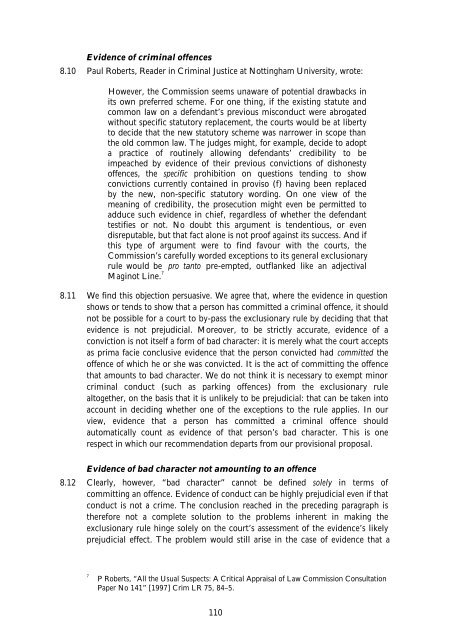Evidence of Bad Character in Criminal ... - Law Commission
Evidence of Bad Character in Criminal ... - Law Commission
Evidence of Bad Character in Criminal ... - Law Commission
Create successful ePaper yourself
Turn your PDF publications into a flip-book with our unique Google optimized e-Paper software.
<strong>Evidence</strong> <strong>of</strong> crim<strong>in</strong>al <strong>of</strong>fences<br />
8.10 Paul Roberts, Reader <strong>in</strong> Crim<strong>in</strong>al Justice at Nott<strong>in</strong>gham University, wrote:<br />
However, the <strong>Commission</strong> seems unaware <strong>of</strong> potential drawbacks <strong>in</strong><br />
its own preferred scheme. For one th<strong>in</strong>g, if the exist<strong>in</strong>g statute and<br />
common law on a defendant’s previous misconduct were abrogated<br />
without specific statutory replacement, the courts would be at liberty<br />
to decide that the new statutory scheme was narrower <strong>in</strong> scope than<br />
the old common law. The judges might, for example, decide to adopt<br />
a practice <strong>of</strong> rout<strong>in</strong>ely allow<strong>in</strong>g defendants’ credibility to be<br />
impeached by evidence <strong>of</strong> their previous convictions <strong>of</strong> dishonesty<br />
<strong>of</strong>fences, the specific prohibition on questions tend<strong>in</strong>g to show<br />
convictions currently conta<strong>in</strong>ed <strong>in</strong> proviso (f) hav<strong>in</strong>g been replaced<br />
by the new, non-specific statutory word<strong>in</strong>g. On one view <strong>of</strong> the<br />
mean<strong>in</strong>g <strong>of</strong> credibility, the prosecution might even be permitted to<br />
adduce such evidence <strong>in</strong> chief, regardless <strong>of</strong> whether the defendant<br />
testifies or not. No doubt this argument is tendentious, or even<br />
disreputable, but that fact alone is not pro<strong>of</strong> aga<strong>in</strong>st its success. And if<br />
this type <strong>of</strong> argument were to f<strong>in</strong>d favour with the courts, the<br />
<strong>Commission</strong>’s carefully worded exceptions to its general exclusionary<br />
rule would be pro tanto pre-empted, outflanked like an adjectival<br />
Mag<strong>in</strong>ot L<strong>in</strong>e. 7<br />
8.11 We f<strong>in</strong>d this objection persuasive. We agree that, where the evidence <strong>in</strong> question<br />
shows or tends to show that a person has committed a crim<strong>in</strong>al <strong>of</strong>fence, it should<br />
not be possible for a court to by-pass the exclusionary rule by decid<strong>in</strong>g that that<br />
evidence is not prejudicial. Moreover, to be strictly accurate, evidence <strong>of</strong> a<br />
conviction is not itself a form <strong>of</strong> bad character: it is merely what the court accepts<br />
as prima facie conclusive evidence that the person convicted had committed the<br />
<strong>of</strong>fence <strong>of</strong> which he or she was convicted. It is the act <strong>of</strong> committ<strong>in</strong>g the <strong>of</strong>fence<br />
that amounts to bad character. We do not th<strong>in</strong>k it is necessary to exempt m<strong>in</strong>or<br />
crim<strong>in</strong>al conduct (such as park<strong>in</strong>g <strong>of</strong>fences) from the exclusionary rule<br />
altogether, on the basis that it is unlikely to be prejudicial: that can be taken <strong>in</strong>to<br />
account <strong>in</strong> decid<strong>in</strong>g whether one <strong>of</strong> the exceptions to the rule applies. In our<br />
view, evidence that a person has committed a crim<strong>in</strong>al <strong>of</strong>fence should<br />
automatically count as evidence <strong>of</strong> that person’s bad character. This is one<br />
respect <strong>in</strong> which our recommendation departs from our provisional proposal.<br />
<strong>Evidence</strong> <strong>of</strong> bad character not amount<strong>in</strong>g to an <strong>of</strong>fence<br />
8.12 Clearly, however, “bad character” cannot be def<strong>in</strong>ed solely <strong>in</strong> terms <strong>of</strong><br />
committ<strong>in</strong>g an <strong>of</strong>fence. <strong>Evidence</strong> <strong>of</strong> conduct can be highly prejudicial even if that<br />
conduct is not a crime. The conclusion reached <strong>in</strong> the preced<strong>in</strong>g paragraph is<br />
therefore not a complete solution to the problems <strong>in</strong>herent <strong>in</strong> mak<strong>in</strong>g the<br />
exclusionary rule h<strong>in</strong>ge solely on the court’s assessment <strong>of</strong> the evidence’s likely<br />
prejudicial effect. The problem would still arise <strong>in</strong> the case <strong>of</strong> evidence that a<br />
7 P Roberts, “All the Usual Suspects: A Critical Appraisal <strong>of</strong> <strong>Law</strong> <strong>Commission</strong> Consultation<br />
Paper No 141” [1997] Crim LR 75, 84–5.<br />
110

















